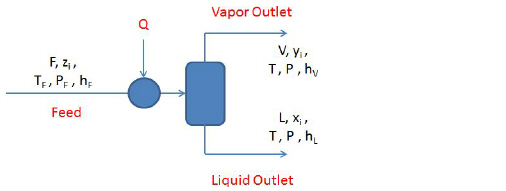
This operation is used to simulate a single-stage flash process.
A flash is a single-equilibrium-stage distillation in which a feed is partially vaporized (or condensed) to give a vapor richer (or a liquid poorer) than the feed in the more volatile components. A flash separation is based on the principle that when two or more phases are in thermodynamic equilibrium, the pressure, temperature and partial fugacity of a component is the same in each phase while its composition is different.

Given that thermodynamic equilibrium imposes equal vapor and liquid phase temperature T and pressure P, the following equations apply for the single-stage flash of the figure above.
|
Name |
Formula |
|
|
|
|
|
|
Total Mass Balance |
|
|
|
Component Mass Balance |
|
|
|
Phase Equilibrium |
|
|
|
Summation Constraint |
|
|
|
Energy Balance |
|
where V, L are the molar flowrates of the vapor and liquid stream and yi, xi denote the molar fraction of component i in the vapor and liquid stream, respectively. The phase equilibrium ratios, Ki, can be evaluated by one of the following thermodynamic models:
● Raoult’s Law
● Hybrid Raoult’s law/Custom vapor fraction model
● Modified Raoult’s Law
● Equation of State (EOS)
● Gamma-Phi Model
For a detailed description of the available options for the calculation of the K-value of a mixture please see Phase Equilibrium Ratio (K-Value) in Phase Equilibrium Ratio (K-Value).
For more details on the fundamental theory and numerical solution of the flash problem, see The Single-Stage Flash in Appendix D .
In Design Mode, the program calculates the volume of the flash drum by the following equation:
|
|
where L the molar flowrate of the liquid stream, τr is the residence time and β is the working-to-vessel volume ratio.
In Rating Mode, the user specifies the vessel volume, the number of units and (from the Volumes tab) either the residence time, τr, or the working-to-vessel volume ratio, β. When the τr is specified, the program calculates β by eq. (A.270) volume ratio by equations and validates that the calculated value is between the allowable range. Similarly, when β is specified the program calculates the residence time, τr.
If this unit operates in batch mode, the feed flowrate F is calculated by dividing the volume of material that needs to be processed per cycle by the process time.
Equipment purchase cost is based on the total vessel volume and material of construction.
1. Seader J.D., Henley E.J. and Roper D.K., Separation Process Principles. Chemical and Biochemical Operations, John Wiley & Sons (2010).
The interface of this operation has the following tabs:
● Oper. Cond’s, see Flash Evaporation: Oper. Conds Tab
● Volumes, see Continuous Vessel Operations (Design Mode): Volumes Tab and Continuous Vessel Operations (Rating Mode): Volumes Tab
● Toolbox Options, see Flash Evaporation: Toolbox Options Tab
● Numerics, see Flash Evaporation: Numerics Tab
● Labor, etc, see Operations Dialog: Labor etc. Tab
● Description, see Operations Dialog: Description Tab
● Batch Sheet, see Operations Dialog: Batch Sheet Tab
● Scheduling, see Operations Dialog: Scheduling Tab